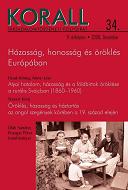Földöröklés egy székely köznemesi családban a 18. század közepén
Land Inheritance in a Sekler Gentry Family in the Mid-Eighteenth Century
Author(s): Sándor OláhSubject(s): History
Published by: KORALL Társadalomtörténeti Egyesület
Summary/Abstract: This study examines the land inheritance practices of an eighteenth-century Sekler gentry family. The main source is an inheritance agreement signed in May 1755, which recorded the distribution of property among three siblings and their families after the death of the parents. The inter-generational transference of estates is characterised by male inheritance, females received movable property at the time of their marriage. The siblings took into account the size of the plots, soil quality, the financial situation of the families, and their earlier, unresolved property history. They divided and assumed individual ownership over the 138 separate plots of land inherited from their parents, however, their ownership was not entirely individual in the modern sense of the word. According to their original ownership status the plots of land were categorised into ancient and pledged estates, that is, acquisitions. Not every inherited estate was divided, undivided estates were inheritable and sometimes even remained in shared use. For the three heirs, ancient property was a joint institution, which helped to maintain social cohesion: it controlled actions and imposed duties on landowners for the benefit of social and individual security. Pledged property was considered individual acquisition, thus the user of these lands assumed full right of disposal over them, as long as the pledger or their relative did not redeem those as ‘closer kin’ on the basis of fee tail rights. Thus, besides the joint and individual ownership by siblings, the inter-generational transference of estates involved the exclusive franchise ‘by blood’ and the shared responsibilities of fee tail. Temporary property rights over pledged estates were similar to property rights over individualised, privately owned property: heirs did not have a strict duty to keep them together.
Journal: Korall - Társadalomtörténeti folyóirat
- Issue Year: 2008
- Issue No: 34
- Page Range: 56-67
- Page Count: 12
- Language: Hungarian

